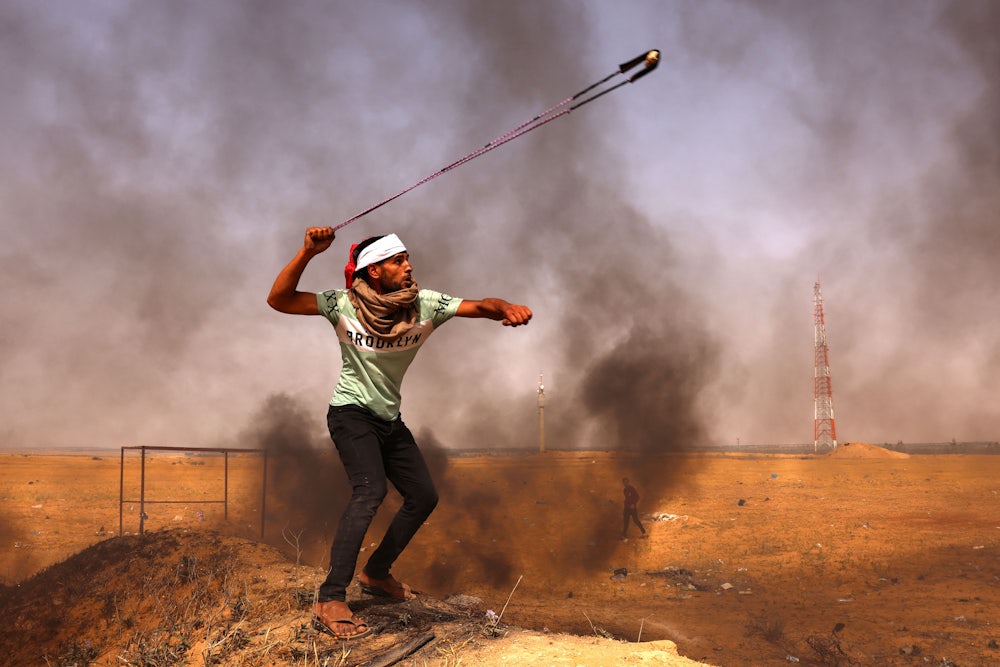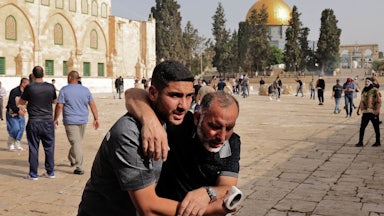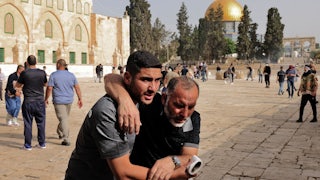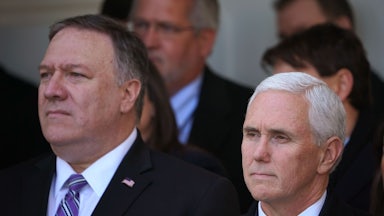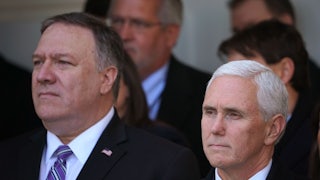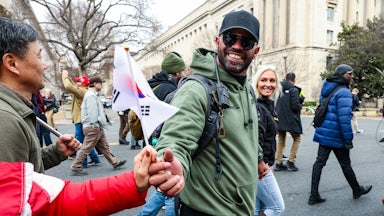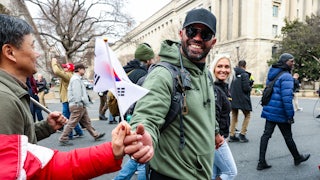Using the discharge of incendiary devices across the wall that hems in the Gaza Strip against the Mediterranean Sea as justification, Israel, under new Prime Minister Naftali Bennett, launched a series of airstrikes in the besieged coastal enclave on Tuesday night. Since Gaza was pulverized by an 11-day-long Israeli bombardment in May, fears had been growing that this scenario, or one similar to it, would play out should the fragile ceasefire reached between Hamas and Israel crack, if the latter does not address the state of siege in Gaza and the grievances brought about by its occupation of the West Bank.
Tuesday night’s hostilities served as a reminder that the cause of the May conflict is far from settled. The looming expulsion of several Palestinian families from their homes in the East Jerusalem neighborhood of Sheikh Jarrah—to make way for Israeli settlers—became the spark that ignited the Israeli bombardment of Gaza last month and saw rockets lobbed on Israeli cities, leaving 256 Palestinians and 13 citizens and residents of Israel dead.
And now, those families inch closer to the crucial date of July 20, when the Israeli Supreme Court will hold a hearing and possibly issue a ruling determining the fate of these families. The Israeli Supreme Court had delayed a decision on the expulsion in mid-May just after the hostilities commenced.
This comes after Israel’s attorney general recently informed the court that he will not intervene in the legal proceedings of the case, meaning he won’t get in the way of the evictions that could still proceed, potentially igniting another conflagration.
“The attorney general (i.e., the state) is essentially abdicating responsibility for these measures of forced displacement, despite the fact that the state is involved at all levels in facilitating these settler-initiated evictions,” said Amy Cohen, director of international relations and advocacy at Ir Amim, an Israeli rights group that focuses on Jerusalem.
“It is presumed that the court will not rule in favor of the families, thus likely paving the way for their eviction,” she said.
Sheikh Jarrah is one of the first neighborhoods directly north of the Old City of Jerusalem, and home to a number of U.N. agencies and diplomatic offices. According to medieval tradition, it also houses the tomb of Simeon the Just (or Shimon HaTzadik in Hebrew). A small Jewish community settled around his tomb in the late 1800s, and the land there was bought by the Jewish community and put in a trust. This is now the basis for Israeli settler groups’ push to evict the Palestinian community that lives there.
During the 1970s, these Israeli settler organizations went to court arguing that these houses were built on Jewish land; in effect, invoking a law that allows Jews to claim property lost in the 1948 war—a right denied to Palestinians. “What’s happening now has been happening since the 1970s,” said Muna Dajani, 38, a Palestinian environmental researcher whose extended family faces eviction from their home in Sheikh Jarrah.
“The takeover has been gradual,” Dajani said. “The settler organizations filed court cases against the families after the 1967 war. Years of procrastination in courts that are a Kafkaesque labyrinth—this is how we have been living, knowing that there are court cases against us.”
Since May 16, Israeli police have cordoned off the eastern part of Sheikh Jarrah, where the Palestinian families under threat of eviction reside. This came after a car-ramming attack by a Palestinian into a police roadblock left a number of Israeli policemen injured.
Access to the area has been obstructed by a heavy presence of armed police, according to Ir Amim. While the entry of supporters of Palestinian residents is prohibited, supporters of Jewish settlers living in the area are allowed to move freely in and out of the neighborhood.
Israeli authorities say that this is an attempt to prevent demonstrations from spiraling into full-out violence, but Palestinians believe it’s designed to cut the neighborhood off from its supporters and suppress mass mobilization.
“It is an attempt to isolate Sheikh Jarrah from broader Palestinian society, and to intimidate the population of the neighborhood,” said Fadi Quran, a West Bank–based community organizer and a director at Avaaz, an online campaigning organization. “The theory here is that the longer these measures are in place, the quicker the Sheikh Jarrah community and Palestinians at large will give up their struggle to remain.”
Tensions eased after the May 20 ceasefire, but things are once again heating up in the occupied territories. Gaza’s residents lived through another night of terror on Tuesday after helium balloons carrying incendiary devices were floated onto Israeli territory. This came after the “Flag Day” march by far-right Israeli groups, postponed several times due to tensions, was allowed to move forward by the new coalition government. Israeli police cleared Damascus Gate and nearby areas of Palestinians to allow the flag-waving parade to take place.
The shaky ceasefire was already put to the test last week, in Sheikh Jarrah, when Israeli police shot a 16-year-old Palestinian girl in the back with a sponge-tipped bullet. Footage of the incident shows her going into the courtyard of her home when she is struck, the incident leaving her bedridden with a fractured spine.
Meanwhile, prominent journalists and activists from the neighborhood are being systematically arrested by authorities. Palestinian twins Mohammed and Muna El-Kurd, 23, who have become impromptu spokespeople for the families facing eviction in Sheikh Jarrah, were also detained and interrogated by Israeli authorities before being released. A day earlier, a reporter for the Qatari Al Jazeera news channel was detained and beaten. She was released several hours after her arrest with a broken arm and a 15-day ban from the neighborhood.
“The police closure imposed on Sheikh Jarrah and the continued heavy presence of armed paramilitary police in Sheikh Jarrah and Silwan [is] a means to crush the civil resistance against their forced displacement,” Cohen said. “It is no surprise that the police intentionally targeted and arrested leading activists and community leaders in both Sheikh Jarrah (Mohammed and Muna El-Kurd) and Silwan (Zuhair Rajabi) last week as a means to intimidate and silence their protest.”
The unrest in Sheikh Jarrah has drawn international condemnation and support, fueled in part by the social media efforts of Palestinian youth like the El-Kurds, high-profile activists whose family has lived in the neighborhood since 1956, when Jordan administered the West Bank. Half of their home is already occupied by Israeli settlers, as per another court order back in 2009.
“What makes Sheikh Jarrah significant is the length of this story,” said Mohammed El-Kurd. “We’ve been in this so-called legal battle since 1972, and during that period, Israeli settler organizations not only have harassed and bullied us but also colluded with the Israeli government to intimidate us.”
The potential for these expulsions, and similar ones in Silwan, are feeding into fears that yet another round of violence will erupt. In the Batn al-Hawa area of Silwan, many Palestinian families are similarly facing expulsion from their homes, and their fates rest with the Israeli judiciary.
“The status quo and relative calm in not only Sheikh Jarrah, but across East Jerusalem, is indeed not sustainable,” Cohen said. “We are witnessing the most concerted and comprehensive mass Palestinian displacement and settler takeover campaign in East Jerusalem since 1967, which is being waged by powerful, well-funded settler groups that enjoy immense support and legitimacy from the government.”
A U.N. survey carried out in 2020 showed that at least 218 Palestinian households have eviction cases filed against them, the majority initiated by settler organizations, placing 970 people, including 424 children, at risk of displacement.
The majority of new cases were identified in the Batn al-Hawa area of Silwan, which remains the community with the highest number of people at risk of displacement, due to ongoing eviction cases, according to the U.N.
If the expulsions occur, many are concerned that “there will definitely be a return to heightened confrontations and mass protests,” Quran said. “Moreover, elements in [the new Israeli government] may seek to further provoke violence as a means to achieve political goals. In short, there’s a high probability of further escalation this summer.”
